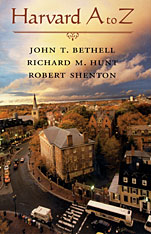
Open this book and step into the storied corridors of the nation’s oldest university; encounter the historic landmarks and curiosities; and among them, meet the famous dropouts and former students, the world-class scholars, eccentrics, and prodigies who have given the institution its incomparable character.
An alphabetical compendium of short but substantial essays about Harvard University—its undergraduate college and nine professional schools—this volume traverses the gamut of Harvardiana from Aab and Admissions to X Cage and Z Closet. In between are some two hundred entries written by three Harvard veterans who bring to the task over 125 years of experience within the university. The entries range from essential facts to no less interesting ephemera, from the Arnold Arboretum designed by Frederick Law Olmsted to the peculiar medical specimens of the Warren Museum; from Arts and Athletics to Towers and Tuition: from the very real environs (Cambridge, Charles River, and Quincy Street) to the Harvard of Hollywood and fiction.
Harvard A to Z is a browser’s delight, offering readers the chance to dip into the history and lore, the character and culture of America’s foremost institution of higher learning.

In the early years of the twentieth century, President Charles William Eliot fought to keep Harvard from becoming a refuge for “the stupid sons of the rich.” A. Lawrence Lowell, a tireless builder, gave the modern University its physical structure. James Conant helped forge a wartime alliance of universities, industry, and government that sustained an astonishingly prosperous postwar epoch.
Their successors saw Harvard through the turbulent 1960s and 1970s, adapting the University’s programs and policies to the needs of a rapidly changing society, strengthening longstanding bonds with international institutions, and creating new ties to the cultures of Japan, China, and other Eastern nations.
In words and pictures, Harvard Observed documents the shaping of the singular institution that poet and essayist David McCord, a former Harvard Alumni Bulletin editor, called “the haven of scholars and teachers, the laboratory of scientists and technicians, the church of the theologian, the crow’s nest of the visionary, the courtroom of the law, the forum of the public servant. It is gallery, concert hall, and stage; the out-patient ward for the medical student, counting-house of the businessman, classroom of the nation, lecture platform for the visitor, library to the world; and…‘on of the great achievements of American democracy.’”
Depicting the evolution of twentieth-century Harvard in the broader context of national and world events, Harvard Observed has much to say and show about the academic rites, intellectual arguments, sexual mores, fads, and folklore that became touchstones for successive generations of Harvardians. Photographs, drawings, and paintings from the University’s vast archival collections and museums add a compelling visual dimension.
READERS
Browse our collection.
PUBLISHERS
See BiblioVault's publisher services.
STUDENT SERVICES
Files for college accessibility offices.
UChicago Accessibility Resources
home | accessibility | search | about | contact us
BiblioVault ® 2001 - 2024
The University of Chicago Press









